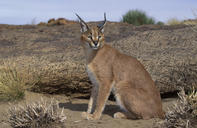Mood Indicators
Cats use their ears to demonstrate their mood. Caracals’ ears, as well as the striking black and white facial markings, which are present from birth, are used to emphasize their expressions.

Being territorial, caracals prefer to live alone. Their markings come in useful when they interact with an intruder and the ears are then used as a signalling system, the black tufts perfectly highlighting their position. Caracals in visual display will face each other, move their heads side to side and flick their ears to show hostility to each other.
By warding off potential contestants without actually engaging in combat reduces the risk of personal injury.
Follow Me

The black ears are also used as “follow me” signs to youngsters following behind in long grass. The black stands out against the tawny grass and the tawny cat but because it’s behind the animal, it doesn’t give away the camouflage.
Caracal kittens have their characteristic pronounced facial markings from birth. They also have a pronounced vocabulary communicating initially with high pitched twitters, which quickly develop into full-blown feline purrs, hisses, growls and spits. Hunting instincts are also present from early on.
Like many other mammals, youngsters use the time while parents are away hunting or guarding territories to play - stalking things like lizards and insects and thereby honing muscles and practising skills they will need later on in life to survive.
Juveniles stay with their mothers until they are about ten months old and then they disperse into a solitary existence of their own up to 180 km away from their natal turf.
By Megan Emmett